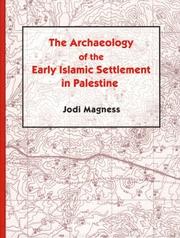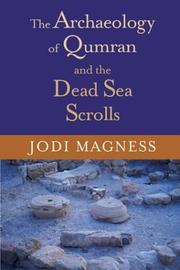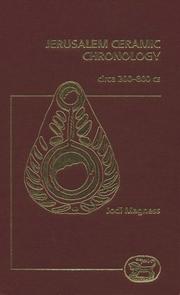| Listing 1 - 10 of 30 | << page >> |
Sort by
|
Multi
ISBN: 9780521124133 9780521195355 9781139013833 0521195357 0521124131 9781139518215 1139518216 1139013831 1107223431 1139507745 1139513788 1283575000 9786613887450 1139517287 1139516361 1139514717 Year: 2012 Publisher: New York, NY Cambridge University Press
Abstract | Keywords | Export | Availability | Bookmark
 Loading...
Loading...Choose an application
- Reference Manager
- EndNote
- RefWorks (Direct export to RefWorks)
This book provides an introduction to the archaeology and history of ancient Palestine - modern Israel, Jordan and the Palestinian territories - from the destruction of Solomon's temple in 586 BCE to the Muslim conquest in 640 CE. Special attention is paid to the archaeology of Jerusalem and the Second Temple period, in the time of Herod the Great and Jesus. For each period, the book offers a historical background for the Mediterranean world and the ancient Near East, as well as the events in Palestine. Major sites such as Masada, Caesarea Maritima and Petra are examined in archaeological and historical detail, along with the material culture - coins, pottery, glass and stone vessels - of each period. This book provides a thorough overview of the archaeology of this historically vibrant part of the world.
Archeology --- Bible --- Palestine --- Excavations (Archaeology) --- Fouilles (Archéologie) --- Antiquities. --- Antiquités --- 902 <33> --- -Archeologie--Oud-Palestina. Judea --- -Holy Land --- -Antiquities. --- -902 <33> Archeologie--Oud-Palestina. Judea --- Archeologie--Oud-Palestina. Judea --- Fouilles (Archéologie) --- Antiquités --- ART --- Archäologie. --- Excavations (Archaeology). --- History --- Ancient & Classical. --- Bible. --- Middle East --- Palästina. --- 902 <33> Archeologie--Oud-Palestina. Judea --- Biblia --- Arts and Humanities --- Religion

ISBN: 157506538X 9781575065380 1575060701 9781575060705 Year: 2004 Publisher: Warsaw : Eisenbrauns, Incorporated
Abstract | Keywords | Export | Availability | Bookmark
 Loading...
Loading...Choose an application
- Reference Manager
- EndNote
- RefWorks (Direct export to RefWorks)
Annotation
Excavations (Archaeology) --- Islamic antiquities --- Antiquities, Islamic --- Antiquities, Muslim --- Muslim antiquities --- Antiquities --- Archaeological digs --- Archaeological excavations --- Digs (Archaeology) --- Excavation sites (Archaeology) --- Ruins --- Sites, Excavation (Archaeology) --- Archaeology --- Negev (Israel) --- Israel --- Negeb (Israel) --- Antiquities. --- Fouilles (Archéologie) --- Antiquités islamiques --- Néguev (Israël) --- Israël --- Antiquités --- Social Science --- Behavioral sciences --- Human sciences --- Sciences, Social --- Social science --- Social studies --- Civilization --- Archaeology. --- Social sciences
Book
ISBN: 9780691167107 0691167109 0691186014 0691216770 Year: 2019 Publisher: Princeton, NJ : Princeton University Press,
Abstract | Keywords | Export | Availability | Bookmark
 Loading...
Loading...Choose an application
- Reference Manager
- EndNote
- RefWorks (Direct export to RefWorks)
Two thousand years ago, 967 Jewish men, women, and children - the last holdouts of the revolt against Rome following the fall of Jerusalem and the destruction of the Second Temple - reportedly took their own lives rather than surrender to the Roman army. This dramatic event, which took place on top of Masada, a barren and windswept mountain overlooking the Dead Sea, spawned a powerful story of Jewish resistance that came to symbolize the embattled modern State of Israel. The first extensive archaeological excavations of Masada began in the 1960s, and today the site draws visitors from around the world. And yet, because the mass suicide was recorded by only one ancient author - the Jewish historian Josephus - some scholars question if the event ever took place. Jodi Magness, an archaeologist who has excavated at Masada, explains what happened there, how we know it, and how recent developments might change understandings of the story. Incorporating the latest findings, she integrates literary and historical sources to show what life was like for Jews under Roman rule during an era that witnessed the reign of Herod and Jesus's ministry and death. Featuring numerous illustrations, this is an engaging exploration of an ancient story that continues to grip the imagination today.
Jews --- 902 <33 MASADA> --- 902 <33 MASADA> Archeologie--Oud-Palestina. Judea--MASADA --- Archeologie--Oud-Palestina. Judea--MASADA --- Hebrews --- Israelites --- Jewish people --- Jewry --- Judaic people --- Judaists --- Ethnology --- Religious adherents --- Semites --- Judaism --- History --- Masada Site (Israel) --- Ḥorvot Metsadah (Israel) --- Ḥorvot Meẓada (Israel) --- Massada Site (Israel) --- Mazada Site (Israel) --- Metsada Site (Israel) --- Metsadah Site (Israel) --- Meẓada (Fortress), Israel --- Meẓada Site (Israel) --- Sabba Site (Israel) --- Sebbe Site (Israel) --- Israel --- History. --- Antiquities --- Excavations (Archaeology) --- Fouilles (Archéologie) --- Juifs --- Massada (Israël : Forteresse)

ISBN: 9780802826879 0802826873 Year: 2003 Publisher: Grands Rapids: Eerdmans,
Abstract | Keywords | Export | Availability | Bookmark
 Loading...
Loading...Choose an application
- Reference Manager
- EndNote
- RefWorks (Direct export to RefWorks)
Book
ISBN: 0802865585 Year: 2011 Publisher: Grand Rapids, Mich. Eerdmans
Abstract | Keywords | Export | Availability | Bookmark
 Loading...
Loading...Choose an application
- Reference Manager
- EndNote
- RefWorks (Direct export to RefWorks)
Bible --- Archeology
Book
ISBN: 9780802865588 Year: 2011 Publisher: Grand Rapids Eerdmans
Abstract | Keywords | Export | Availability | Bookmark
 Loading...
Loading...Choose an application
- Reference Manager
- EndNote
- RefWorks (Direct export to RefWorks)
"In Stone and Dung, Oil and Spit Jodi Magness unearths 'footprints' buried in both archaeological and literary evidence to shed new light on Jewish daily life in Palestine from the mid-first century b.c.e. to 70 c.e. the time and place of Jesus' life and ministry. Magness analyzes recent archaeological discoveries from such sites as Qumran and Masada together with a host of period texts, including the New Testament, the works of Josephus, and rabbinic teachings. Layering all these sources together, she reconstructs in detail a fascinating variety of everyday activities dining customs, Sabbath observance, fasting, toilet habits, burial customs, and more" -- BACK COVER.
Jews --- Judaism --- History --- Social life and customs

ISBN: 1850754136 Year: 1993 Publisher: Sheffield JSOT
Abstract | Keywords | Export | Availability | Bookmark
 Loading...
Loading...Choose an application
- Reference Manager
- EndNote
- RefWorks (Direct export to RefWorks)
Excavations (Archaeology) --- Islamic pottery --- Pottery, Ancient --- Pottery, Byzantine --- Pottery, Roman --- Jerusalem --- Antiquities.

ISBN: 0802845894 Year: 2002 Publisher: Grand Rapids (Mich.): Eerdmans
Abstract | Keywords | Export | Availability | Bookmark
 Loading...
Loading...Choose an application
- Reference Manager
- EndNote
- RefWorks (Direct export to RefWorks)
Excavations (Archaeology) --- Qumran community --- Dead Sea scrolls. --- Qumran Site (West Bank)
Book
ISBN: 9780691186016 Year: 2019 Publisher: Princeton, NJ
Abstract | Keywords | Export | Availability | Bookmark
 Loading...
Loading...Choose an application
- Reference Manager
- EndNote
- RefWorks (Direct export to RefWorks)
Book
ISBN: 9780190937805 0190937807 Year: 2024 Publisher: New York, NY : Oxford University Press,
Abstract | Keywords | Export | Availability | Bookmark
 Loading...
Loading...Choose an application
- Reference Manager
- EndNote
- RefWorks (Direct export to RefWorks)
"The knobbiest town in the world"--so Samuel Clemens (aka Mark Twain) described Jerusalem in The Innocents Abroad, a travelogue of his visit to the Holy Land in 1867 (Fig. 0.7). He was struck by the Old City's small size; the small white domes protruding like knobs from the flat roofs of the tightly-packed houses; the narrow, crooked, uneven stone-paved streets; the poverty and filth; and the throngs of beggars: "To see the numbers of maimed, malformed and diseased humanity that throng the holy places and obstruct the gates, one might suppose that the ancient days had come again, and that the angel of the Lord was expected to descend at any moment to stir the waters of Bethesda. Jerusalem is mournful, and dreary, and lifeless. I would not desire to live here." The nineteenth century witnessed the beginning of scientific exploration of the Holy Land, as European colonial powers sought to gain a foothold in Ottoman Palestine amid growing scientific interest in using archaeology to verify the Bible. Thousands of westerners--clerics, scholars, military men, pilgrims, adventure-seekers, and tourists--poured into the country. Twain vividly describes the overwhelming experience of sightseeing in Jerusalem: "We are surfeited with sights. Nothing has any fascination for us, now, but the Church of the Holy Sepulchre. We have been there every day, and have not grown tired of it; but we are weary of every thing else. The sights are too many. They swarm about you at every step; no single foot of ground in all Jerusalem or within its neighborhood seems to be without a stirring and important history of its own. It is a very relief to steal a walk of a hundred yards without a guide along to talk unceasingly about every stone you step upon and drag you back ages and ages to the day when it achieved celebrity. It seems hardly real when I find myself leaning for a moment on a ruined wall and looking listlessly down into the historic pool of Bethesda. I did not think such things could be so crowded together as to diminish their interest. But in serious truth, we have been drifting about, for several days, using our eyes and our ears more from a sense of duty than any higher and worthier reason. And too often we have been glad when it was time to go home and be distressed no more about illustrious localities. Our pilgrims compress too much into one day. One can gorge sights to repletion as well as sweetmeats. Since we breakfasted, this morning, we have seen enough to have furnished us food for a year's reflection if we could have seen the various objects in comfort and looked upon them deliberately."
| Listing 1 - 10 of 30 | << page >> |
Sort by
|

 Search
Search Feedback
Feedback About UniCat
About UniCat  Help
Help News
News